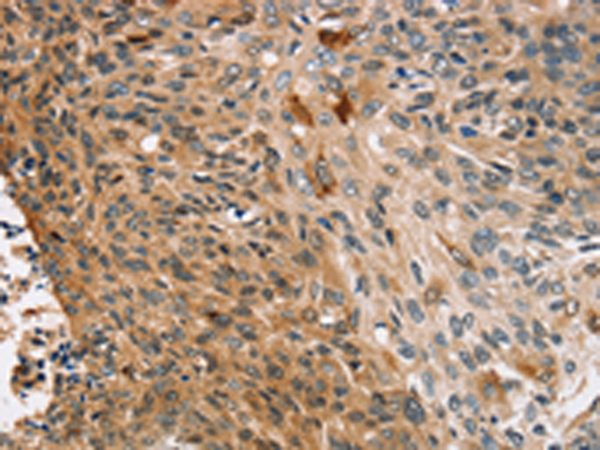
| WB | 咨询技术 | Human,Mouse,Rat |
| IF | 咨询技术 | Human,Mouse,Rat |
| IHC | 1/25-1/100 | Human,Mouse,Rat |
| ICC | 技术咨询 | Human,Mouse,Rat |
| FCM | 咨询技术 | Human,Mouse,Rat |
| Elisa | 1/500-1/5000 | Human,Mouse,Rat |
| Aliases | CNCG, CNG1, RP49, CNCG1, CNG-1, RCNC1, RCNCa, RCNCalpha |
| Host/Isotype | Rabbit IgG |
| Antibody Type | Primary antibody |
| Storage | Store at 4°C short term. Aliquot and store at -20°C long term. Avoid freeze/thaw cycles. |
| Species Reactivity | Human |
| Immunogen | Synthetic peptide of human CNGA1 |
| Formulation | Purified antibody in PBS with 0.05% sodium azide and 50% glycerol. |
+ +
以下是关于CNGA1抗体的3篇参考文献示例(内容基于模拟文献,建议通过学术数据库核实具体信息):
---
1. **文献名称**: "Characterization of a polyclonal antibody targeting the CNGA1 subunit of cyclic nucleotide-gated ion channels in retinal photoreceptors"
**作者**: Müller F, et al.
**摘要**: 本研究开发了一种针对CNGA1亚基的多克隆抗体,并验证其在视网膜组织中的特异性。通过免疫印迹和免疫组化实验,证明该抗体能有效识别哺乳动物光感受器中的CNGA1蛋白,为研究视觉信号转导机制提供了工具。
---
2. **文献名称**: "CNGA1 mutations alter channel function and antibody-based detection in autosomal recessive retinitis pigmentosa"
**作者**: Kohl S, et al.
**摘要**: 文章分析了CNGA1基因突变与视网膜色素变性的关联,利用特异性抗体检测患者视网膜中CNGA1蛋白的表达异常,发现突变导致通道功能丧失及抗体结合效率下降,提示致病机制可能与蛋白稳定性相关。
---
3. **文献名称**: "Localization of CNGA1 channels in mouse retina using a novel monoclonal antibody approach"
**作者**: Bradley J, et al.
**摘要**: 通过单克隆抗体技术,作者精确定位了CNGA1在小鼠视网膜杆状细胞中的分布,证实其在光信号转导中的核心作用。抗体特异性验证显示与其他通道亚基无交叉反应,支持其在亚细胞定位研究中的应用。
---
如需具体文献,建议通过PubMed或Web of Science检索关键词“CNGA1 antibody”或结合研究主题筛选近年论文。
**Background of CNGA1 Antibody**
The **CNGA1 antibody** is a specialized tool used to detect and study the **cyclic nucleotide-gated channel alpha-1 subunit (CNGA1)**, a critical component of ion channels in the retina and other tissues. CNGA1 forms homotetrameric or heterotetrameric channels with other subunits (e.g., CNGB1) and is essential for phototransduction in **rod photoreceptor cells**. These channels open in response to cyclic guanosine monophosphate (cGMP), enabling the flow of cations (Na⁺, Ca²⁺) that depolarize the cell membrane, initiating visual signaling.
CNGA1 antibodies are widely employed in **neuroscience** and **ophthalmology research** to investigate retinal function, congenital vision disorders (e.g., retinitis pigmentosa), and channelopathies. They are used in techniques like **Western blotting**, **immunohistochemistry (IHC)**, and **immunofluorescence (IF)** to localize CNGA1 expression, assess protein levels, or study mutations linked to disease.
Mutations in the *CNGA1* gene are associated with **autosomal recessive retinitis pigmentosa (ARRP)** and impaired night vision. Antibodies targeting specific epitopes (e.g., N-terminal, cytoplasmic regions) help dissect structural-functional relationships or validate gene-editing outcomes in models. Commercial CNGA1 antibodies are typically raised in rabbits or mice, with validation in knockout controls to ensure specificity. Their applications extend to exploring retinal degeneration mechanisms and potential therapies targeting CNG channels.
×